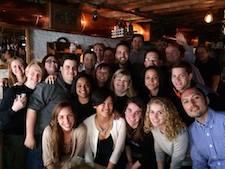April 17, 2014 was the last day for most of the journalists at Digital First Media’s Project Thunderdome.
And it was a sad one, obviously, said Jim Brady, who was DFM’s editor-in-chief at the time. But what he saw that day and in the days leading up to it was something he’d never seen before in journalism. The journalists at DFM’s news hub helped each other with job searches. They made calls. They practiced interviewing together.
“Even people who were competing for the same jobs were helping each other prepare,” said Robyn Tomlin, who was then Thunderdome’s editor. “Unlike situations where only a handful of people are affected, we were all in this together.”
One year later, most of 50 or so people in Thunderome’s newsroom are still in journalism, and most of them have jobs. They’re at Time, ESPN, the Marshall Project, Grist, Yahoo Finance, the Las Vegas Sun, Reuters, Esquire, Facebook, the Los Angeles Times, Fusion, First Look Media, The Guardian, Conde Nast, NPR, the New Haven Register, the New Republic, Storyful, The New York Times and more.
In our industry right now, journalists get laid off. Newsrooms shut down. Publications fold. But what happened to most of Thunderdome’s people is different from other stories we’ve told one year later for a few reasons. To start, most of Thunderdome’s staff lived and worked in a media-rich city and the end of Thunderdome was quite public. Also, they all lost their jobs, not just some staff or even a whole department. The nature of the work they did — adapting quickly, testing, learning, failing and starting again, meant a lot of them were both attractive to other news organizations and that they knew how to pivot and keep moving. And for many of them, the shaky state of the journalism industry is their normal. They’ve been laid off before.
“As hard as situations like this are, they really give you the opportunity to do a gut check about your career path and about what’s important to you,” Tomlin said. “I think each one of us had to do some soul-searching about where we ‘fit’ within the industry after this experience. And while we were all scrambling to find work, most of us wanted to find jobs that left us feeling both as challenged and fulfilled as the ones we were leaving.”
Here’s a look at how seven of the journalists from Project Thunderdome have managed since their final day one year ago.
Business
Yvonne Leow doesn’t quite remember how she felt on that last day. It wasn’t nostalgic — they’d all had plenty of chances to say goodbye. Maybe it was more a sense of excitement for what might come next.
She’d never been laid-off before and didn’t know what to expect, but about two weeks after her last day at Thunderdome, she was chosen as a John S. Knight fellow at Stanford. Six month before the Thunderdome layoffs, Leow’s dream job would have been to work as an interactive editor.
“I would have loved to be producing Snow Fall after Snow Fall,” she said.
Now, she wants to understand the business side of journalism. She’s interested in messaging apps and companies that bring together journalism and tech, such as Medium. Leow doesn’t know exactly what her future looks like, but she wants to get her hands dirty.
“I would like to know how we make money,” she said. “I think overall as an industry, we don’t spend enough time trying to know that or learn that.”
Family
P. Kim Bui had been laid off before. So she knew, going into Project Thunderdome, that anything could happen.
“I wanted to work with the team and I thought interesting things were being done, so I was up for what I thought was a slight risk,” she said. “I was looking for a newsroom where I could push my own boundaries and experiment, and Thunderdome definitely allowed for that.”
Still, it hurt when Thunderdome closed, said Bui, who worked the night shift at the breaking news desk. She hadn’t been there long and felt like she’d lost a family she just found. But because of those previous layoffs, she was at least prepared.
“I had some savings, so I took my time figuring it out,” she said.
It took Bui six months to find her next job.
“I wanted that same feeling I had at Thunderdome, that I could push myself and learn more, so I looked around for that culture, which took time.”
Bui, who’s now the West Coast producer at reported.ly, said the work at Thunderdome also prepared her for where she is now, getting her back to writing, covering international stories and working with a close team.
And she didn’t actually lose that family.
“We often joke that we’ll all cross paths again, and I believe that. Getting laid off makes you way more resilient and accepting to change, and we all have long careers ahead of us.”

Project Thunderdome at ONA’s conference in San Francisco in 2012. In the top row, from left, are Yvonne Leow, Robyn Tomlin, Laura Cochran, Jim Brady, Julie Westfall and Tom Meagher. In the bottom row, from left, are Mandy Jenkins, Chris Hopkins and Mark Lewis. (Photo by Robyn Tomlin.)
News
Kelly Jones knew Thunderdome was closing before the announcement came.
“That didn’t stop me from bawling my eyes out though,” said Jones, who started on the product team, is based in Wyoming and Colorado. “I was devastated.”
“As someone who started in an old school, anti-digital JRC newsroom, I thought the service we were providing was extremely important,” she said. “After visiting several smaller newsrooms, I was constantly aware that what we were providing was important. But the push back we also received was apparent. There was more push back than praise. It was hard. Once that started happening, I had a feeling we weren’t going to last. But I was trying to be an optimist.”
Unlike a lot of her colleagues, Jones’ next move wasn’t to another job in journalism. That’s because there aren’t a lot of places willing to take a chance on someone who wants to work remotely or digitally, she said.
“I have so much motivation – and yet, if I’m not sacrificing my paycheck on rent in New York City, I can’t seem to get back into it,” she said. “I’m not ranting, I promise. I am just unwilling to move from a place where in one weekend, I can camp, hike, bike and so on. It’s liberating.”
Now, she’s working as a document specialist at an oil and gas company. She still misses the news business terribly.
Talent
Meena Thiruvengadam has seen a lot of journalists lose their jobs. She’s seen it, too, in industries that are more stable. Thunderdome’s end felt like the chance for new beginnings elsewhere, “but I was also already starting to feel nostalgic,” said Thiruvengadam, who was the business channel manager. “The Thunderdome was one of the more fun newsrooms I’ve experienced, and our group was a good one.”
About one month after her last day, she started at Yahoo Finance, where she’s an editor. And what she learned at Thunderdome prepared her for what came next.
“Thunderdome was something very different than anything I’d done in my career and really taught me a lot about news products, increased my familiarity with news-related startups and helped me better understand the volume and variety of content partnerships that are out there, something that’s especially helpful in my current job,” she said.
All of that will also have a long-term impact on her career. And she’s not surprised that so many of her former co-workers have landed firmly on their feet. Yes, they’re an adaptive group, but they also worked together to move on.
“We believed in one another enough to recommend each other wholeheartedly, and I think that sent a strong message about the kind of talent that was at the Thunderdome.”
Tattoos
David Freid didn’t think Project Thunderdome would fold.
He moved to New York from L.A. to work as a video producer and video journalist. There, he met Courtney Wells, who was an animator. He doesn’t remember details from the last day, but he does remember the day they learned Thunderdome was shutting down.
“Courtney and I had what I believe is the most appropriate response to professional ruin and went out day-drinking as soon as we heard the news,” Freid said.
After Thunderdome closed, he and Wells started working on a series of video projects for Conde Nast.
“We’ve since formed our own production company and have created video series for Vanity Fair, GQ, and The New York Times, amongst others,” Freid said. They also recently traveled to Thailand, where they got matching tattoos.
At Thunderdome, they were surrounded by the best of the best.
“I wish we had a more time to do great work with what was clearly a talented team there,” Freid said. “I feel like we barely scratched the surface. The best thing that happened to me at Thunderdome was getting to know the people that built it.”
His advice for other journalists pretty much sums up the rest of the advice we gathered from people post-Thunderdome: “Do everything. Be persistent. And don’t be a dick.”
Leaders
Mandy Jenkins was one Thunderdome’s first employees. On July 1 of last year, she was also the last to leave.
Jenkins, who started at Thunderdome as interactive editor, got a job as news editor at Storyful two weeks after her last day in July. When the layoffs came, she was upset but not too worried about the staff.
“We had hired not just for talent, but also for a certain personality type – a willingness to take risks, a desire to experiment, an ability to work independently or play as a teammate,” Jenkins said. “That is exactly the sort of journalist news organizations need.”
At Thunderdome, she got her first experience as a manager and she got to learn from Tomlin and Brady, two of the best newsroom leaders she’s met.
“I had a rare chance to lead a team of people I knew well, many of whom I’d hired, and I could do it in a safe environment with a lot of mentoring when I needed it,” she said. “I think I value that most of all.”
Digital. First.
It’s a shame that Project Thunderdome didn’t last longer, Brady said. A lot of the people in this story felt the same.
“And it’s a shame that in a lot of ways it didn’t get the time to really develop into what it could have been.”
“I did believe Thunderdome was going to get a good runway and get the resources we needed to succeed because John Paton had told us, early on, that as long as he was CEO, there would be a Thunderdome,” Jenkins said. “That ended up not being the case.”
It would have been easy, at the end, for people to feel bitter and angry, Tomlin said.
Instead, on April 17, they threw a going-away party for her and Brady “with cake and spoof pages and gifts for us,” Tomlin said. “These were people we’d just laid off, but here they were — thanking us. It just blew me away. It also showed me that the emphasis we put on hiring quality people and building a collaborative culture was worth it.”
Many of the journalists at Thunderdome started their careers at a time when journalism was in crisis, Brady said.
They still chose journalism.
“That says what they think of the craft. Ask everyone who worked at Thunderdome if they think journalism is dying and not one of them will tell you yes,” he said. “They want to be part of rebuilding it.”
Correction: The second photo in this piece is from ONA’s 2012 conference in San Francisco, not the 2014 conference in Chicago.













